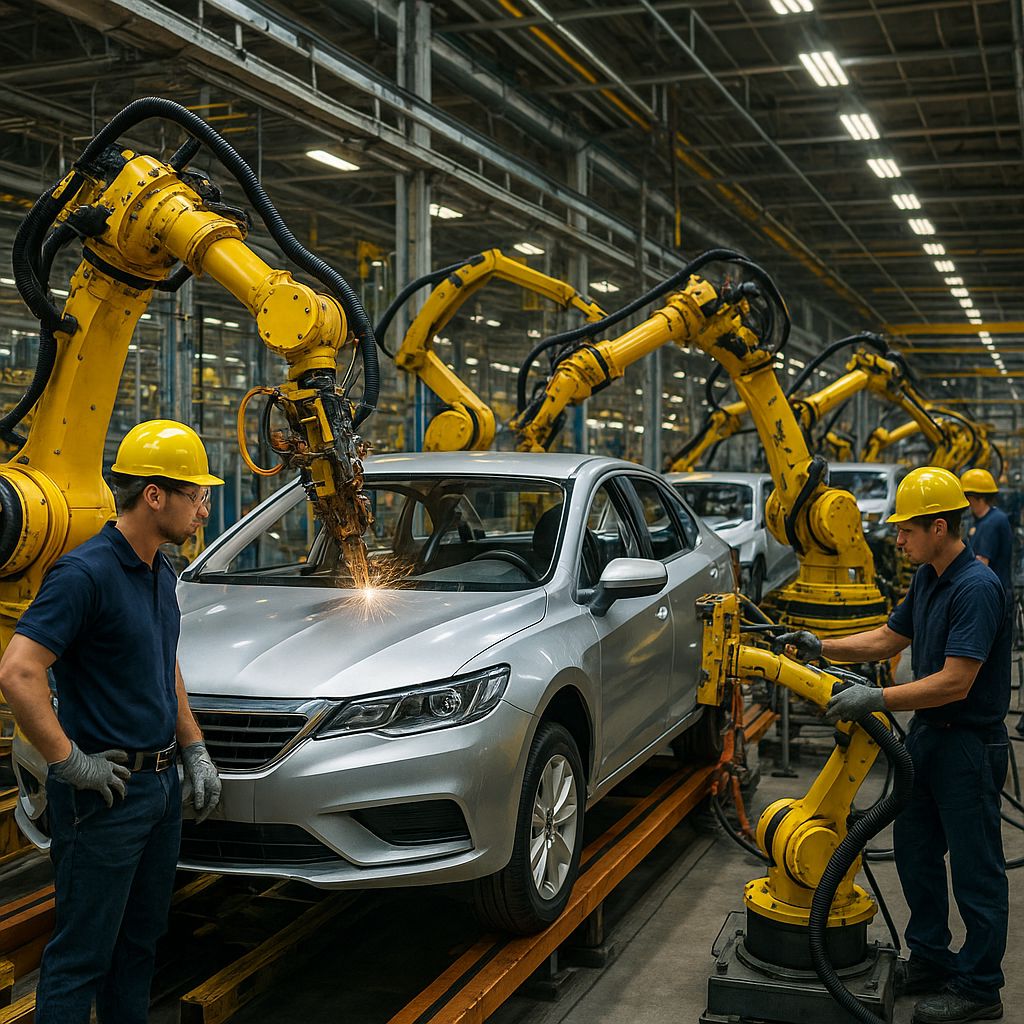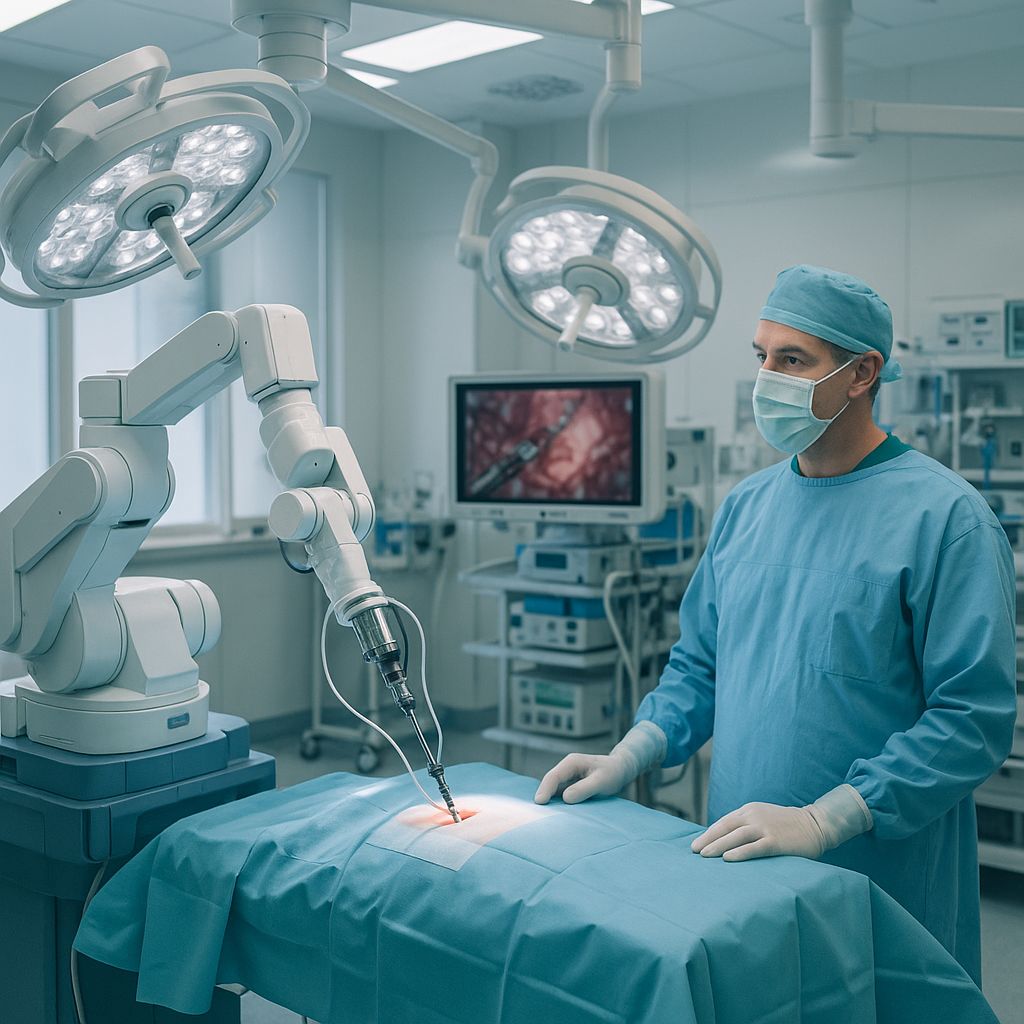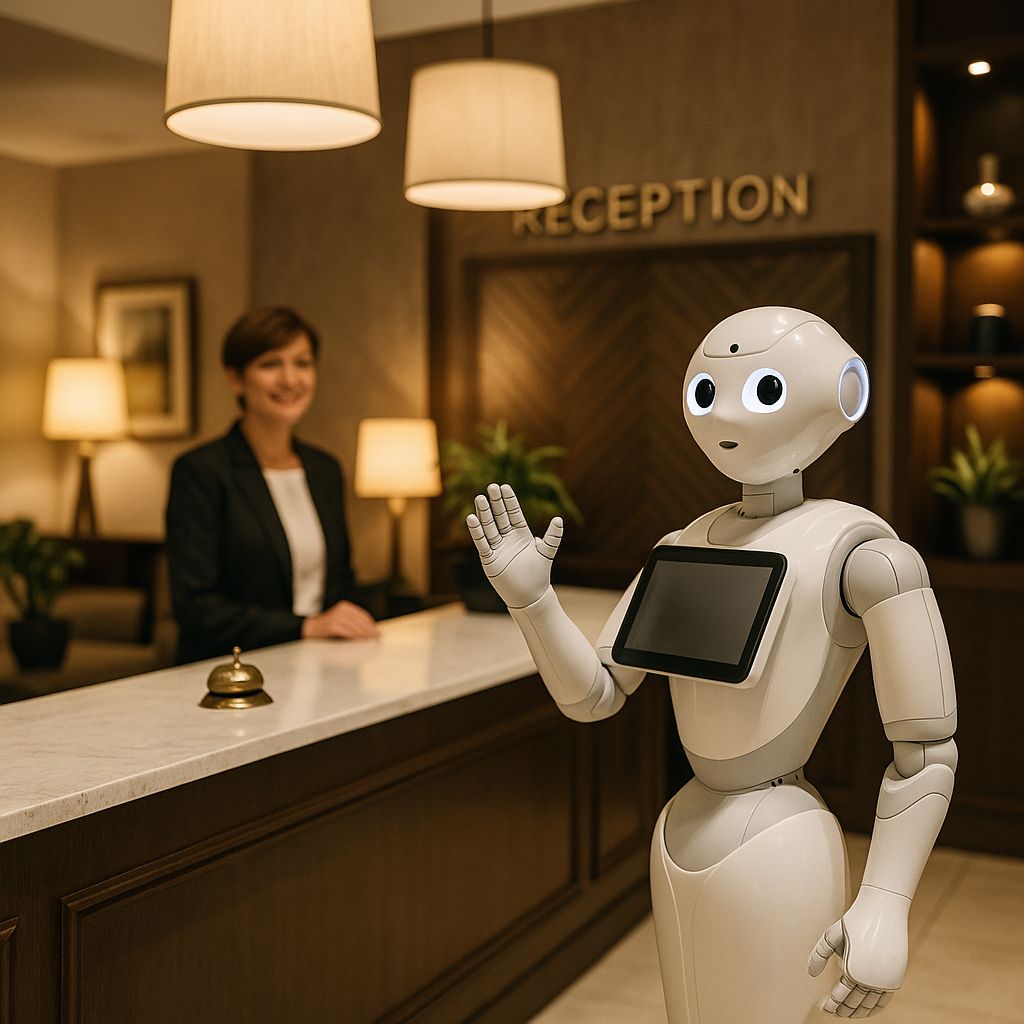When Robots Punch In
The World’s First Machine-Scale Labor Market Is Here—and It’s Reshaping Wages, Work, and What Comes Next
At a bustling warehouse in Columbus, Ohio, a robot named Hal doesn’t take coffee breaks. He doesn’t call in sick. He hums down the aisles with uncanny precision, lifting crates heavier than any human and updating inventory in real-time. Hal is one of 78 robots recently “hired” at a mid-sized logistics firm that laid off nearly 40% of its night crew last quarter. When asked how the staff felt about it, a human worker shrugged: “At least Hal doesn’t steal lunches.” The company’s CEO, meanwhile, called it “a net productivity gain with fewer HR headaches.” Stories like this—equal parts impressive and unnerving—are no longer rare. They’re the future. Welcome to the emerging robot labor market.
The Factory Floor Returns to Life

The robotic revolution is stepping out of the lab and onto the factory floor with record force. According to the International Federation of Robotics (IFR), 2023 saw roughly 4.28 million industrial robots operating in factories worldwide, a 10% jump over the previous year. Demand is surging thanks to advances in artificial intelligence and a push to re-shore production. U.S. manufacturers led growth in North America, installing about 44,300 new industrial robots in 2023 – a 12% rise from 2022. Automakers and electronics firms drove much of this demand, wiring their plants for the age of autonomy. Global spending on new robot installations hit an all-time high of $16.5 billion as factories race to boost output and cope with labor shortages.
In Detroit and beyond, lines once crowded with workers are becoming shared spaces. Robotic arms weld car bodies side-by-side with human technicians, guided by vision sensors and cloud analytics. Elon Musk has even pledged that Tesla will put humanoid “Optimus” robots on its assembly lines. In March 2025 Musk told staff that Tesla aims to build some 5,000 Optimus units this year – dubbing that number a “legion” of robots – and hopes to scale to about 50,000 robots by 2026. The first Optimus was already hand-assembled at Tesla’s Fremont plant. The message is clear: manufacturing’s next workforce may be part human, part machine.
The Rise of Cognitive Manufacturing
Central to this momentum is the incorporation of machine learning and “physical AI” into automation. Robots now train themselves in virtual reality and use generative AI to optimize tasks on the fly. For example, chipmakers and auto suppliers deploy robots with advanced vision systems that adapt to unpredictable parts and assembly variants. These smart robots can identify production flaws in real time and recalibrate without human intervention. Industry leaders are investing not only in cutting-edge machines but in the brains that run them. From Nvidia’s latest AI accelerators for robotics training to specialized software platforms, the robotics supply chain is thick with investment.
Geopolitics has become entwined with robotics strategy. At April’s Robotics Summit in Boston, engineers and investors spent as much time at coffee breaks discussing trade tensions as admiring demos of Boston Dynamics’ Atlas humanoid. Tariffs and export controls on rare-earth magnets and chips (key ingredients for robot motors) have companies rethinking sourcing. On one hand, restrictions from China have delayed some projects – Tesla admitted that Chinese limits on magnets slowed Optimus development. On the other hand, firms see an opportunity to onshore production. “It’s opened up opportunities,” said Agility Robotics CTO Pras Velagapudi, as American businesses look harder for domestic supplies and homegrown robots. Al Makke of auto supplier Schaeffler echoed that higher labor costs and shortages push automation further, adding that “one face of automation is humanoids.” In this climate, startups like Portland’s Agility are raising big capital ($400M reported) to localize humanoid supply chains and already piloting their Digit robots in U.S. plants.
Automated Warehouses and Delivery

Beyond the factory, robots are proliferating through the global supply chain. Warehouses are lit by rows of fleets silently zipping shelves and cartons around. Amazon, a pioneer in warehouse automation, now fields around 750,000 robots in its fulfillment centers worldwide. Last year Amazon opened a new Louisiana facility where dozens of robotic systems – from Kiva mobile pods to AI-driven sorting arms – collaborate with human workers, delivering an estimated 25% productivity boost over traditional operations. Employees walk among these machines, many reporting that automation has made their jobs safer and more satisfying – a recent survey by MIT’s Human Systems Lab found roughly 60% of Amazon warehouse staff saying collaborative robots improved productivity and safety on the floor.
Logistics robotics is booming globally. The IFR reports that transport and logistics topped all categories of professional service robots in 2023, with about 113,000 units sold. These include autonomous forklifts, truck-loading arms, and self-driving tuggers in factories and ports. Startups are driving the last mile as well: semi-autonomous delivery trucks, sidewalk delivery bots, and drones are in pilot programs from California to Guangzhou. In North America, grocery chains are experimenting with autonomous vehicles. Silicon Valley’s Nuro and Kroger have quietly expanded driverless grocery delivery programs, now serving thousands of homes with roving electric vehicles.
At Amazon, investment keeps rolling. In 2024 the company launched a $1 billion Industrial Innovation Fund for supply-chain tech; Amazon Ventures has already backed Agility Robotics ($150M) and other warehouse-robot startups. Tech giants like Tesla and even Apple are tooling up: Tesla’s manufacturing lines and Optimus project aim to drive costs down, and rumors swirl that Apple is building its own assembly bots. Goldman Sachs now projects humanoid robots alone could become a $38 billion market by 2035.
Medicine and Care: Healthcare Robots

On hospital floors and in clinics, robots are shouldering labor shortages too. Surgical robot sales climbed last year, fueled by aging populations and surgeon retirements. Intuitive Surgical’s da Vinci systems (the dominant surgical robots) now number over 10,000 installed worldwide, and new platforms from Medtronic and Johnson & Johnson promise smaller footprints and more automation. The IFR reports that global medical robot shipments jumped 36% in 2023, including a dramatic 128% increase in rehabilitation robots and a 14% rise in surgical units. Robotic exoskeletons and telepresence units are also on the rise.
Hospitals in the U.S. face record staffing gaps – millions of vacancies by 2025. To close them, many are spending on automation. For instance, a consortium of U.S. hospitals announced a $60 million fund to buy logistics robots that shuttle linens and supplies, freeing nursing aides for direct care. In pharmacies, robot dispensers and pill-counting machines are cutting errors and letting pharmacists focus on patient counseling. According to a 2025 survey by the Medical Robot Alliance, nearly 70% of hospital administrators plan to increase spending on robotics and AI this year, citing better outcomes and workflow.
At the patient-facing end, entrepreneurs see a market in home health. SoftBank’s Pepper robot is serving as a concierge in Tokyo clinics and retirement homes, answering questions and leading exercise classes. In the U.S., several nursing homes have started trials of social robots to combat loneliness. The line between medical device and service is blurring: an FDA recently approved a mobile robot for hospital disinfection, touting a 90% cut in harmful pathogens. If any sector feels urgent, it’s healthcare – and robots are charging in to fill gaps that staffing shortages and high costs have created.
Hospitality and the Everyday

The service sector is next in line. Restaurants and hotels are deploying fleets of kitchen and service robots. In quick-service eateries, bots like the new “Flippy Fry Station” now deep-fry and flip fries, onion rings and nuggets. In January 2025 Miso Robotics unveiled a second-generation Flippy – co-developed with NVIDIA and others – that it will lease to chains like White Castle and Jack in the Box. Flippy seats at the fryer for about $5,400 a month and reportedly yields “day one” ROI by cutting labor and food waste.
On dining room floors, robotic waiters are becoming commonplace. Bear Robotics’ mobile servers and other AI waiter robots now work at hundreds of restaurants globally, carrying dishes and drinks to tables. Hotel chains have begun buying robots for room service and cleaning. In 2024 a major U.S. hotel group deployed in-room concierge tablets and wheeled robot “butlers” in dozens of its urban properties. The robot greets guests, responds to voice requests, and delivers towels or snacks on demand – tasks that once tied up front-desk staff.
Even retail is in on the trend. Supermarket giants Kroger and Walmart have field-tested in-aisle robots that scan shelves for out-of-stock items and pricing errors, trimming hours of nightly work. Warehouse “picker” robots in Amazon and Walmart centers now retrieve groceries faster than humans, speeding up online delivery. Experts note that as consumers embrace self-checkout and online ordering, the back-room staff roles are ripe for robotics – and grocers are quietly hiring robotics engineers to develop these systems.
The Numbers Game: Markets and Jobs
All these efforts are remaking economies. The robotics industry itself is a major growth engine: worldwide demand (industrial + professional service robots) is expected to top $16 billion annually by 2025. Venture capital is pouring in, too: robotics startups raised roughly $7–8 billion in 2024, tracking toward new highs. For example, Agility Robotics ( Digit’s maker) has hit a $1.75 billion valuation after its recent raise. Global electronics giants are repositioning themselves as robotics players – LG has made Bear Robotics a majority-owned affiliate, and Samsung has seeded multiple smart factory ventures.
What about jobs? Here the picture is mixed. Economic models project that robots will displace many routine tasks even as they create new ones. A World Economic Forum survey of corporate leaders found that by 2030 employers expect to eliminate 92 million jobs via automation while creating 170 million new roles, many in tech and care industries. Robotics technicians, AI trainers and robot “fleet managers” are now in high demand. Training programs in robot maintenance and automation are popping up at community colleges across the U.S. On the other hand, roles like assembly-line packagers or basic data-entry clerks face steep declines.
Wages are also being influenced. In manufacturing and logistics, employers now compare the multi-year cost of a human worker to the one-time capital cost of a robot. Boston Dynamics highlights that its Spot robot can work 8–12 hours on a charge surveying sites that would take humans days. If a single Spot (about $75,000) replaces a team of inspectors, the savings add up. One U.S. pipeline company reported saving $100,000 annually per inspection zone using robots after accounting for maintenance. Such clear ROI drives more orders: this spring a private equity consortium announced it would acquire dozens of inspection drones and ground robots to lease to infrastructure companies on one-year contracts, banking on annual rental revenue per robot in the tens of thousands.
The rapid rise of robot labor raises thorny social questions. Workforce advocates worry about displacing less-skilled workers. Some cities have begun talking robot taxes or basic income pilots to offset tech-driven job loss. Unions are mobilizing: in May 2025, dockworkers ratified a labor pact with clauses on shipyard automation, reflecting concern over robotic port cranes. Governments are also scrambling. In Washington, Congress has earmarked funds for robotics research and worker retraining. The National Science Foundation allocated $250 million in early 2025 toward “next-gen robotic manufacturing” initiatives, aiming to keep the U.S. competitive with China.
Still, the narrative is not purely dystopian. Companies often pitch robots as collaborators. Ford’s CEO, for instance, has said robotics can take over the “dangerous, dull or dirty tasks” and let humans focus on skilled work. Indeed, many workers report higher job satisfaction when aided by automation; they spend less time on exhausting manual chores and more on programming and oversight. One Amazon manager noted that staff turnover fell after deploying collaborative robots, as employees felt less strain.
In practical terms, robots are fast becoming a commodity factor of production. Advanced economies are integrating them into economic strategy: Germany’s latest AI plan calls robotics “critical infrastructure,” and Japan’s post-pandemic recovery highlights semi-autonomous factories and elder-care robots. The result is a gradual redefinition of “labor.” In this emerging robot economy, machines clock in on corporate registers. They consume electricity, earn carrying costs, and even generate revenue by cutting costs. Speculatively, some technologists envision a future in which highly autonomous robots might even transact in digital markets – perhaps bidding for jobs or purchasing services using crypto-wallets.
For now, the robot labor market is real and growing. This spring’s headlines – from Tesla’s promise of tens of thousands of humanoids to Agility’s $400M raise to hospitals contracting for surgical bots – herald a historic shift. The frontier between human work and machine work is blurring across industries. But as machines begin to earn their keep, what happens to our social contracts, our job ladders, our sense of purpose? Will humans retain the final say—or will the market decide that cognition without biology is cheaper, faster, and more reliable? Our economy is, bit by bit, becoming a hybrid one where millions of robots join the workforce. I am curious to see how we will integrate these machines into our economic fabric.

Dylan Jorgensen
Dylan Jorgensen is an AI enthusiast and self-proclaimed professional futurist. He began his career as the Chief Technology Officer at a small software startup, where the team had more job titles than employees. He later joined Zappos, an Amazon company, immersing himself in organizational science, customer service, and unique company traditions. Inspired by a pivotal moment, he transitioned to creating content and launched the YouTube channel “Dylan Curious,” aiming to demystify AI concepts for a broad audience.
Sources:
IFR World Robotics Reports and press releases: ifr.org
Amazon company news: aboutamazon.com
Tesla Q1 2025 update: teslarati.com
Agility Robotics funding announcement: geekwire.com
Times Union/AP coverage of robotics summit: timesunion.com
Wired magazine analysis: wired.com
MedCityNews healthcare robotics overview: medcitynews.com
World Economic Forum jobs report commentary: weforum.org
Miso Robotics press release: misorobotics.com misorobotics.com

